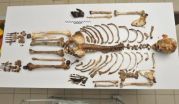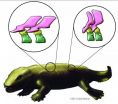(Press-News.org) PHILADELPHIA, PA (January 14, 2013)—Breast cancer is the second leading cause of cancer deaths among women in the United States. Many of these deaths occur when there is an initial diagnosis of invasive or metastatic disease. A protein called NEDD9—which regulates cell migration, division and survival—has been linked to tumor invasion and metastasis in a variety of cancers. Researchers at Fox Chase Cancer Center have now shown that NEDD9 plays a surprising role in the early stages of breast tumor development by controlling the growth of progenitor cells that give rise to tumors. The findings, published in the journal Oncogene on January 14, 2013, could lead to personalized treatment strategies for women with breast cancer based on the levels of NEDD9 in their tumors.
"For several years, NEDD9 has been linked to tumor metastasis and invasion at later stages. This is the first study that really shows how important NEDD9 can be for the initiation of tumors in breast cancer, and to link this initiation process to progenitor cells," says lead study author Joy Little, PhD, a postdoctoral fellow at Fox Chase who works in the laboratory of senior study investigator Erica A. Golemis, PhD, Deputy Chief Scientific Officer and Vice President at Fox Chase.
In the study, Little, Golemis and their collaborators mated mice without the NEDD9 gene to mice engineered to develop HER2+ mammary tumors and unexpectedly found that these mice were largely resistant to tumor formation. Only 18% of the mice developed mammary tumors, compared with 80% of mice that had a functional NEDD9 gene. In contrast to previous research findings showing that an increase in NEDD9 levels promotes tumor aggressiveness, the researchers found that loss of NEDD9 had little effect on tumor metastasis, indicating that it is not required for this process in this specific context. Once formed, the tumors in mice lacking NEDD9 grew rapidly, suggesting that it either plays a less important role at later stages of tumor growth or tumors undergo compensatory changes that allow them to bypass the need for NEDD9.
Importantly, mice lacking NEDD9 showed a significant reduction in progenitor cell populations in the mammary gland compared with mice that had a functional NEDD9 gene. Progenitor cells from NEDD9-null mice were less likely to form three-dimensional mammospheres in culture, but proliferated at the same rate as cells from control mice. The loss of Nedd9 also made progenitor cells more sensitive to lower doses of two tumor-inhibiting drugs—a Food and Drug Administration-approved Src inhibitor called dasatinib, and a focal adhesion kinase inhibitor from a class of drugs currently being tested in clinical trials for the treatment of cancer. These findings suggest that these types of drugs would more effectively control breast cancer tumors with low levels of NEDD9.
"Eventually, with a biopsy, you may be able to get a read-out of all the mutations that a tumor has, and each one would potentially dictate whether or not a certain line of therapy would work for a specific tumor," Little says. "If NEDD9 levels are higher in a particular tumor, we could potentially determine whether or not it would be more sensitive to specific inhibitors."
To follow up on this work, the researchers plan to determine the mechanisms by which NEDD9 controls tumor formation, and examine whether NEDD9 plays a similar role in early stages of other types of cancer.
### Co-authors on the study include Victoria Serzhanova, Eugene Izumchenko, Brian L. Egleston, Andres J. Klein-Szanto, and Maria Shubina of Fox Chase; Erica Parise of the University of Pittsburgh; Grace Loudon of Bryn Mawr College; Sachiko Seo and Mineo Kurokawa of the University of Tokyo; and Michael F. Ochs of Johns Hopkins University.
Fox Chase Cancer Center, part of the Temple University Health System, is one of the leading cancer research and treatment centers in the United States. Founded in 1904 in Philadelphia as one of the nation's first cancer hospitals, Fox Chase was also among the first institutions to be designated a National Cancer Institute Comprehensive Cancer Center in 1974. Fox Chase researchers have won the highest awards in their fields, including two Nobel Prizes. Fox Chase physicians are also routinely recognized in national rankings, and the Center's nursing program has received the Magnet status for excellence three consecutive times. Today, Fox Chase conducts a broad array of nationally competitive basic, translational, and clinical research, with special programs in cancer prevention, detection, survivorship, and community outreach. For more information, visit Fox Chase's Web site at www.foxchase.org or call 1-888-FOX CHASE or (1-888-369-2427).
Fox Chase researchers discover novel role of the NEDD9 gene in early stages of breast cancer
2013-01-14
ELSE PRESS RELEASES FROM THIS DATE:
Pill-sized device provides rapid, detailed imaging of esophageal lining
2013-01-14
Physicians may soon have a new way to screen patients for Barrett's esophagus, a precancerous condition usually caused by chronic exposure to stomach acid. Researchers at the Wellman Center for Photomedicine at Massachusetts General Hospital (MGH) have developed an imaging system enclosed in a capsule about the size of a multivitamin pill that creates detailed, microscopic images of the esophageal wall. The system has several advantages over traditional endoscopy.
"This system gives us a convenient way to screen for Barrett's that doesn't require patient sedation, a ...
The secrets of a tadpole's tail and the implications for human healing
2013-01-14
Scientists at The University of Manchester have made a surprising finding after studying how tadpoles re-grow their tails which could have big implications for research into human healing and regeneration.
It is generally appreciated that frogs and salamanders have remarkable regenerative capacities, in contrast to mammals, including humans. For example, if a tadpole loses its tail a new one will regenerate within a week. For several years Professor Enrique Amaya and his team at The Healing Foundation Centre in the Faculty of Life Sciences have been trying to better understand ...
Cancer suppressor gene links metabolism with cellular aging
2013-01-14
PHILADELPHIA - It is perhaps impossible to overstate the importance of the tumor suppressor gene p53. It is the single most frequently mutated gene in human tumors. p53 keeps pre-cancerous cells in check by causing cells, among other things, to become senescent – aging at the cellular level. Loss of p53 causes cells to ignore the cellular signals that would normally make mutant or damaged cells die or stop growing.
In short, the p53 pathway is an obvious and attractive target for drug developers. But that strategy has so far proven difficult, as most p53 regulatory proteins ...
The genome of diamondback moth provides new clues for sustainable pest management
2013-01-14
January 13, 2013, Fujian and Shenzhen, China- An international research consortium, led by Fujian Agriculture, Forestry University (FAFU) and BGI, has completed the first genome sequence of the diamondback moth (DBM), the most destructive pest of brassica crops. This work provides wider insights into insect adaptation to host plant and opens new ways for more sustainable pest management. The latest study was published online today in Nature Genetics.
The diamondback moth (Plutella xylostella) preferentially feeds on economically important food crops such as rapeseed, cauliflower ...
What did our ancestors look like?
2013-01-14
A new method of establishing hair and eye colour from modern forensic samples can also be used to identify details from ancient human remains, finds a new study published in BioMed Central's open access journal Investigative Genetics. The HIrisPlex DNA analysis system was able to reconstruct hair and eye colour from teeth up to 800 years old, including the Polish General Wladyslaw Sikorski (1881 to 1943) confirming his blue eyes and blond hair.
A team of researchers from Poland and the Netherlands, who recently developed the HIrisPlex system for forensic analysis, have ...
New study reveals gas that triggers ozone destruction
2013-01-14
Scientists at the Universities of York and Leeds have made a significant discovery about the cause of the destruction of ozone over oceans.
They have established that the majority of ozone-depleting iodine oxide observed over the remote ocean comes from a previously unknown marine source.
The research team found that the principal source of iodine oxide can be explained by emissions of hypoiodous acid (HOI) – a gas not yet considered as being released from the ocean – along with a contribution from molecular iodine (I2).
Since the 1970s when methyl iodide (CH3I) was ...
Graphene plasmonics beats the drug cheats
2013-01-14
Writing in Nature Materials, the scientists, working with colleagues from Aix-Marseille University, have created a device which potentially can see one molecule though a simple optical system and can analyse its components within minutes. This uses plasmonics – the study of vibrations of electrons in different materials.
The breakthrough could allow for rapid and more accurate drug testing for professional athletes as it could detect the presence of even trace amounts of a substance.
It could also be used at airports or other high-security locations to prevent would-be ...
Scientists reassemble the backbone of life with a particle acceleratorynchrotron X-rays
2013-01-14
This press release is available in French and German.
Jointly issued with STFC and the Royal Veterinary College London.
Scientists have been able to reconstruct, for the first time, the intricate three-dimensional structure of the backbone of early tetrapods, the earliest four-legged animals. High-energy X-rays and a new data extraction protocol allowed the researchers to reconstruct the backbones of the 360 million year old fossils in exceptional detail and shed new light on how the first vertebrates moved from water onto land. The results are published 13 January ...
Foot soldiers of the immune system
2013-01-14
Researchers at McGill University and the Research Center for Molecular Medicine (CeMM) of the Austrian Academy of Sciences have discovered the molecular blueprint behind the IFIT protein. This key protein enables the human immune system to detect viruses and prevent infection by acting as foot soldiers guarding the body against infection. They recognize foreign viral ribonucleic acid (RNA) produced by the virus and act as defender molecules by potentially latching onto the genome of the virus and preventing it from making copies of itself, blocking infection. The findings ...
Smoking intensity and cancer markers predict seriousness of bladder cancer
2013-01-14
Smoking not only causes bladder cancer—it also affects its course, in that people who smoke more have greater likelihood of developing more aggressive and deadly disease. That is one of the conclusions of a new study published early online in CANCER, a peer-reviewed journal of the American Cancer Society. The study also found that a panel of bladder cancer markers can predict which particular cases are at the highest risk for a fatal outcome.
Researchers have known that smoking is one of the most common causes of bladder cancer, but they've wondered whether it also affects ...


